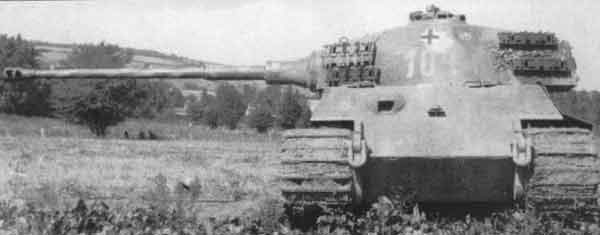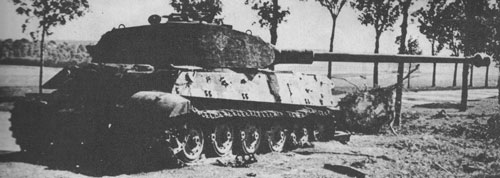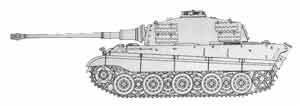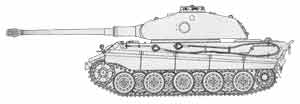|
|
|
KING TIGER
KING TIGER
 Panzerkampfwagen Tiger Ausf. B | |
|
The clash of armour on the eastern front created an arms race of armour between Germany and Russia
that sparked a rapid evolution in tank design. Since the invasion of the Soviet Union in 1941
until the collapse of Germany in 1945 each side competed to put the best machine on the battlefield.
German AFVs put to the challenge of defeating Russia in 1941 had as thin as 13mm of armour to a maximum of
50mm while its main gun was as small as a 37 or 50mm weapon. Some vehicles carried a 75mm gun but
this was designed for infantry support and was of the low velocity type. At that time successful
for that role but until modified it was only good against tanks at close range. However, by 1944
armour thickness could be as much as 200mm with a 128mm main gun capable of shooting armour
piercing rounds. The Strumtiger actually had a 380mm gun that fired a special projectile to
destroy enemy fortifications.
But it wasn't mass and might alone that was evolving. Technology in making tanks that weighed
nearly 70 tons maneuver and handle all sorts of terrain had to keep pace with the capability
to deliver a deadly blow and to withstand one as well.
Perhaps the best example of this is the German's Königster. In English that would be King or Royal
Tiger, but it is commonly known as the Tiger II, which was the largest, heaviest and most
formidable tank to see combat during World War Two. The front armour was 150mm thick at 40º
deflection that added to its protection against armour piercing rounds. The sides of the hull was
80mm thick as was the sides and back of the turret. The standard Henschel turret was 180mm thick
in the front. This tank was certainly not indestructible but at times it was frustrating trying. | |
 As tough as the King Tiger was, this was the fate of most. | |
|
The 88mm 71 cal. gun on the Tiger II was more powerful than the 88mm 56 cal. gun on the Tiger I and had better velocity at 3,220 fps. This could penetrate 182mm of 30º armour at 500 yards. This was more than enough to deal with Russia's JS 2 tanks. On the western front, America never really fielded a true competitor until so late in the war that accounts are scarce. The Tiger II carried 84 rounds and they weighed 37 pounds each. The beginnings of the Tiger II actually date back to August 1942 when specifications were issued for a modified Tiger I, incorporating the slopped armour of the revolutionary Russian T-34 design. As with the Panther, the Germans were tying to design steps ahead of their competition. Porsche and Henschel presented proposals for this new panzer and it appeared Porsche would get the nod to fill the production order but being that the copper needed for the electric transmission was scarce in Germany, affecting production time tables, Henschel took over. This was not so until Porsche had completed 50 turrets, that is why pictures show Tiger IIs with two different looking turrets. The Henschel design was better than the Porsche because the underside slop of the turret could deflect enemy rounds into the hull (This is called a shot trap), whereas Henschel's 180mm thick front armour of the turret would not. Compare the two below. | |

|

|
|
50 of this type was the first produced. | |
|
LESSONS LEARNED |
|
|
DRAWBACKS |
|
|
Even with it's drawbacks, the Tiger II was a great tank with many excellent design features. Surprisingly capable of greater maneuverability than some smaller allied tanks on certain terrain. |

|
|
Specifications of the | |
WEIGHT | 68 Tons |
|---|---|
CREW | 5 |
ARMAMENT | 88mm & 2 mg |
ARMOUR | 150mm |
ENGINE | Maybach HL 230 P30 |
SPEED | 26 MPH (42km/h) |
RANGE | 106 miles (170km) |
LENGHT | 33.79' (10.3m) |
WIDTH | 12.33' (3.76m) |
HEIGHT | 10.1' (3.08m) |
| HOME | TOP | BACK |